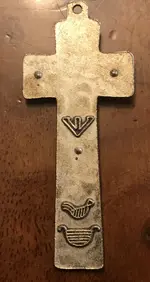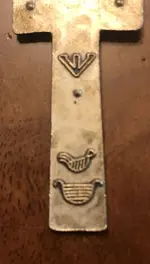You are using an out of date browser. It may not display this or other websites correctly.
You should upgrade or use an alternative browser.
You should upgrade or use an alternative browser.
Help with marks on cross
- Thread starter jtw1313
- Start date
CrankyBuzzard
Jr. Member
- Joined
- Jul 6, 2020
- Messages
- 94
- Reaction score
- 180
- Golden Thread
- 0
- Location
- North Texas USA
- Detector(s) used
- Garrett AT Max and White's Spectra
- Primary Interest:
- All Treasure Hunting
Upvote
0
- Joined
- Dec 23, 2019
- Messages
- 6,340
- Reaction score
- 20,229
- Golden Thread
- 0
- Location
- Surrey, UK
- Primary Interest:
- All Treasure Hunting
Yes, it’s a ‘Penal Cross’.
The National Museum of Ireland has a different interpretation of the ‘Cock and Pot’ from that given on the New Zealand site linked above. The museum says it has its roots in the story of Judas from the Gospel of Nicodemus. Following his betrayal of Christ, Judas returns to his home with the intention of killing himself. His wife is roasting a cock over the fire. She tells a distressed Judas that Jesus is as likely to rise from the dead as the cock she is cooking is likely to come to life. With that the cock flew out of the pot and crowed.
From the museum website:
Penal crosses represented devotional artefacts. Their name derives from the fact that they were somewhat contemporaneous with the Penal Laws. The Penal Laws created a wave of economic, social and religious hardship across Ireland. The penal cross signified a tangible, portable relic of worship for Catholics whose religion was under great threat. In his study, A.T. Lucas suggests a range of dates from the eighteenth to early nineteenth century for penal crosses [those originally carved from a piece of wood, rather than this modern version in metal].
It is thought that they have a strong association with the pilgrimage site at Lough Derg, County Donegal where they were made and sold to pilgrims visiting the site and subsequently kept as relics. Lucas states that:
“The manufacture of crucifixes of an undoubted “penal” type in the locality for sale to the pilgrims of the mid-nineteenth, suggests the possibility that the whole genus of these objects may be associated with the Lough Derg pilgrimage” (Lucas, 1954, p. 168).
The National Museum of Ireland has a different interpretation of the ‘Cock and Pot’ from that given on the New Zealand site linked above. The museum says it has its roots in the story of Judas from the Gospel of Nicodemus. Following his betrayal of Christ, Judas returns to his home with the intention of killing himself. His wife is roasting a cock over the fire. She tells a distressed Judas that Jesus is as likely to rise from the dead as the cock she is cooking is likely to come to life. With that the cock flew out of the pot and crowed.
From the museum website:
Penal crosses represented devotional artefacts. Their name derives from the fact that they were somewhat contemporaneous with the Penal Laws. The Penal Laws created a wave of economic, social and religious hardship across Ireland. The penal cross signified a tangible, portable relic of worship for Catholics whose religion was under great threat. In his study, A.T. Lucas suggests a range of dates from the eighteenth to early nineteenth century for penal crosses [those originally carved from a piece of wood, rather than this modern version in metal].
It is thought that they have a strong association with the pilgrimage site at Lough Derg, County Donegal where they were made and sold to pilgrims visiting the site and subsequently kept as relics. Lucas states that:
“The manufacture of crucifixes of an undoubted “penal” type in the locality for sale to the pilgrims of the mid-nineteenth, suggests the possibility that the whole genus of these objects may be associated with the Lough Derg pilgrimage” (Lucas, 1954, p. 168).
Upvote
0
Tony in SC
Gold Member
- Joined
- Jun 8, 2006
- Messages
- 6,410
- Reaction score
- 9,246
- Golden Thread
- 0
- Location
- Upstate South Carolina
- Detector(s) used
- Whites, Minelab, Tesoro, and custom machines
- Primary Interest:
- Metal Detecting
As usual, NICE piece my friend!
Upvote
0
cw0909
Silver Member
the symbol thats unidentified on the front of the crucifix in this link
is the bowl and or jug that was used to wash Christ feet
https://onedaysgrace.co.nz/products/irish-penal-crucifix
is the bowl and or jug that was used to wash Christ feet
https://onedaysgrace.co.nz/products/irish-penal-crucifix
Last edited:
Upvote
0
Similar threads
- Replies
- 5
- Views
- 420
Users who are viewing this thread
Total: 1 (members: 0, guests: 1)






